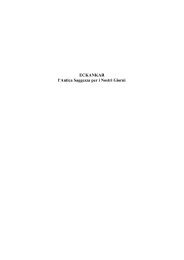Where Were You Before the Tree of Life? - Horus Centre
Where Were You Before the Tree of Life? - Horus Centre
Where Were You Before the Tree of Life? - Horus Centre
You also want an ePaper? Increase the reach of your titles
YUMPU automatically turns print PDFs into web optimized ePapers that Google loves.
inhospitable arctic regions which begin at 55 degrees latitude in eastern America, do not start<br />
until 70 degrees north latitude in Norway. Unaffected by <strong>the</strong> Gulf Stream, Labrador is sub-arctic<br />
though at <strong>the</strong> same latitude as England.<br />
If <strong>the</strong> Gulf Stream’s influence were removed, by, say a large continental island in <strong>the</strong> middle<br />
<strong>of</strong> <strong>the</strong> Atlantic such as Atlantis was supposed to have been, it would mean that <strong>the</strong> climate <strong>of</strong><br />
north-western Europe would undergo a radical change, and would <strong>the</strong>n become normal for that<br />
kind <strong>of</strong> latitude.<br />
During <strong>the</strong> Pleistocene Epoch <strong>of</strong> Earth’s history, <strong>the</strong>re was about <strong>the</strong> same amount <strong>of</strong> ice<br />
cover to <strong>the</strong> east <strong>of</strong> <strong>the</strong> Atlantic as <strong>the</strong>re was to <strong>the</strong> west. Both continents were buried under huge<br />
ice caps that occasionally reached as far down as 50 degrees north latitude. The limits <strong>of</strong><br />
glaciation leave <strong>the</strong>ir mark in <strong>the</strong> form <strong>of</strong> piled up rock called terminal moraines. The belts <strong>of</strong><br />
terminal moraines found in Canada and Europe, which indicate <strong>the</strong> sou<strong>the</strong>rn limit <strong>of</strong> advance <strong>of</strong><br />
inland ice sheets, clearly show that during <strong>the</strong> Ice Age northwestern Europe did not enjoy a better<br />
climate than nor<strong>the</strong>astern America. Thus it can be concluded that <strong>the</strong> Gulf Stream did not flow or<br />
did not reach northwest Europe during that time, blocked as it would have been at <strong>the</strong> time by <strong>the</strong><br />
remaining islands <strong>of</strong> Atlantis.<br />
Experts differ as to exactly when <strong>the</strong> Earth moved into its fifth geological age. Experts using<br />
different criteria place <strong>the</strong> time from 20,000 to 8,000 years ago. One scientist counting <strong>the</strong> bands<br />
<strong>of</strong> Swedish varved clay, arrived at an “optimum” <strong>of</strong> 12,000 to 10,000 years BC, <strong>the</strong> time when <strong>the</strong><br />
final remnants <strong>of</strong> Atlantis were supposed to have sunk beneath <strong>the</strong> ocean. This means that much<br />
<strong>of</strong> England and most <strong>of</strong> Nor<strong>the</strong>rn Europe only became hospitable for human habitation after <strong>the</strong><br />
sinking <strong>of</strong> Atlantis. As we can see from recorded history, this is exactly <strong>the</strong> time when civilization<br />
began to take root on <strong>the</strong> European continent.<br />
It is also postulated that <strong>the</strong> Mayans, being one <strong>of</strong> <strong>the</strong> outerlying colonies <strong>of</strong> Atlantis which<br />
survived <strong>the</strong> global changes <strong>of</strong> that time, date <strong>the</strong>ir calendar from <strong>the</strong> destruction <strong>of</strong> Atlantis . . .<br />
June 5, 8498 BC, just as <strong>the</strong> Romans began counting <strong>the</strong>ir calendar from <strong>the</strong> founding <strong>of</strong> Rome<br />
and <strong>the</strong> Christians from <strong>the</strong> birth <strong>of</strong> Christ.<br />
Edgar Cayce’s Atlantis readings are important to a concept <strong>of</strong> our history, not only because<br />
<strong>the</strong>y were given to help individuals, but also because <strong>the</strong>y were given to help mankind. They point<br />
out very strongly <strong>the</strong> cyclical nature <strong>of</strong> history—those things which we do not learn from and<br />
which keep cropping up again and again until we learn <strong>the</strong>ir hard lessons. In <strong>the</strong> case <strong>of</strong> <strong>the</strong> life<br />
readings dealing with past incarnations in Atlantis <strong>the</strong>n, <strong>the</strong> problems described seem to have a<br />
special urgency, a special relevance to <strong>the</strong> events going on today.<br />
According to Cayce, many <strong>of</strong> <strong>the</strong> people he did readings for who lived in Atlantis were<br />
active, influential, and capable individuals. His suggestion in <strong>the</strong>se readings, however, is that<br />
<strong>the</strong>se past Atlanteans are once again incarnating on <strong>the</strong> planet in hope that <strong>the</strong>y may once again<br />
be able to greatly influence <strong>the</strong> world events currently taking place—that is, to right some wrongs,<br />
to heal some old wounds, and potentially to divert <strong>the</strong> course <strong>of</strong> world events away from fur<strong>the</strong>r<br />
destruction.<br />
Much has been written about Atlantis, but it is Ignatius Donnelly in particular who, much like<br />
Churchward for Lemuria, is <strong>the</strong> best-known proponent <strong>of</strong> its existence. As W. Scott-Elliot says <strong>of</strong><br />
Donnelly’s arguments for <strong>the</strong> existence <strong>of</strong> Atlantis, <strong>the</strong>y excited a good deal <strong>of</strong> interest and<br />
respect when he made <strong>the</strong>m in 1882. Today, however, <strong>the</strong>y would probably be dismissed by<br />
133



